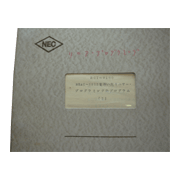NEC's early hardware comprised parametron computers (e.g., NEAC-1101) and transistor-based computers (e.g., NEAC-2203). As software for these early computers, standard routines were provided, and the user created software using these standard routines.
In addition, online real-time systems were provided by specialized machines.
(1) Examples of standard routines with NEAC-2203
These experiences were utilized in developing successors, including NEAC-2230. Programs such as the SNAC macro assembler and the NARC compiler, which were based on program files on magnetic tapes, were developed later and evolved into operating systems (OS) based on magnetic tapes.
- Initial program
A loader for inputting a machine language program from a paper tape, it had a relative address processing function for the start address. - SIP (Symbolic Input Processor)
SIP was a one-pass assembler. Common specifications were established under the guidance of Dr. Shigeichi Moriguchi to be shared among companies for educational purposes. - NEAC-2203 assembler
This was a two-pass assembler with which the object program was output to a paper tape. - NARC compiler
This was a compiler for scientific computation with which the object program was output to a paper tape. - Scientific computation subroutines
Subroutines for elementary functions, matrix computation and statistical computation - Magnetic tape-based sorting program
It used four magnetic tapes. - Other utility routines
These experiences were utilized in developing successors, including NEAC-2230. Programs such as the SNAC macro assembler and the NARC compiler, which were based on program files on magnetic tapes, were developed later and evolved into operating systems (OS) based on magnetic tapes.
(2) Specialized machines
Online real-time computers designed to computerize seat reservation systems and bill processing were developed as specialized machines.
Because these computers were wired-program systems in which functional operations were determined by logical wiring, it was difficult to change or expand the systems after installation.
Its experience in developing specialized machines led NEC to recognize the need to develop a system with a general-purpose machine that used programs, and to develop an operating system (OS).
Online real-time computers designed to computerize seat reservation systems and bill processing were developed as specialized machines.
Because these computers were wired-program systems in which functional operations were determined by logical wiring, it was difficult to change or expand the systems after installation.
Its experience in developing specialized machines led NEC to recognize the need to develop a system with a general-purpose machine that used programs, and to develop an operating system (OS).


